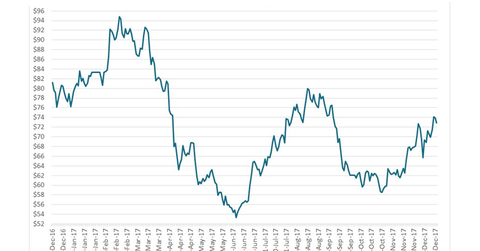Iron Ore Investors Could Anticipate These Factors in 2018
Iron ore prices were tumultuous throughout 2017. There is a 44% difference between the peak of $95 per ton in February and the trough of $53 per ton experienced in July.
Jan. 2 2018, Updated 7:33 a.m. ET

Iron ore prices
Iron ore prices were tumultuous throughout 2017. There is a 44% difference between the peak of $95 per ton reached by iron ore prices in February 2017 and the trough of $53 per ton experienced in July 2017.
The most recent weakness was again experienced in September when prices fell 18% in a single week on fears of China’s steel capacity cuts. After that, prices again started surging.
Most recently, iron ore prices rose 5% on December 22, 2017, to climb to a fresh three-month high of $76.40 per ton. This rally was supported by an increase in steel prices in China as production remains low due to cuts and demand from southern China remains firm.
Seaborne imports rising
Another factor supporting seaborne iron ore prices is the Chinese mills’ switch from domestic ore to imported iron ore. In a bid to control pollution, mills are shifting steel production to more high-quality and low-impurity imported iron ore.
Imported ore, particularly from iron ore giants (PICK) such as BHP (BHP), Vale (VALE), and Rio Tinto (RIO), is higher-grade and lower-pollution ore. Despite capacity cuts, demand for imported ore has risen, replacing domestically mined ore.
Differential and impact on miners
The miners we’ve mentioned above are the ones that usually produce higher content ore, getting premium to the 62% iron ore content benchmark price. Miners such as the Australian division of Cleveland-Cliffs (CLF) and Fortescue Metals Group (FSUGY), on the other hand, are attracting discounts due to their lower iron ore content material.
In this series, we’ll explore the potential course iron ore prices could take. We’ll also look at the forward-looking and coincident indicators for iron ore.
